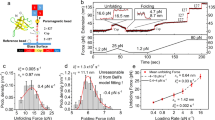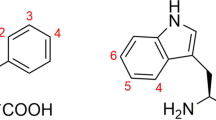Abstract
The cold shock protein CspB from Bacillus subtilis is only marginally stable, but it folds extremely fast in a simple N ⇌ U two-state reaction. The corresponding cold shock proteins from the thermophile Bacillus caldolyticus and the hyperthermophile Thermotoga maritima show strongly increased conformational stabilities, but unchanged very fast two-state refolding kinetics. The absence of intermediates in the folding of B. subtilis CspB is thus not a corollary of its low stability. Rather, two-state folding and an unusually native-like activated state of folding seem to be inherent properties of these small all-β proteins. There is no link between stability and folding rate, and numerous sequence positions exist which can be varied to modulate the stability without affecting the rate and mechanism of folding.
This is a preview of subscription content, access via your institution
Access options
Subscribe to this journal
Receive 12 print issues and online access
$189.00 per year
only $15.75 per issue
Buy this article
- Purchase on Springer Link
- Instant access to full article PDF
Prices may be subject to local taxes which are calculated during checkout
Similar content being viewed by others
References
Kim, P.S. & Baldwin, R.L. Specific intermediates in the folding reactions of small proteins and the mechanism of protein folding. Annu. Rev. Biochem. 51, 459–489 (1982).
Kim, P.S. & Baldwin, R.L. Intermediates in the folding reactions of small proteins. Annu. Rev. Biochem. 59, 631–660 (1990).
Jaenicke, R. Folding and association of proteins. Prog. Biophys. molec. Biol. 49, 117–237 (1987).
Kuwajima, K. The molten globule as a clue for understanding the folding and cooperativity of globular-protein structure. Proteins Struct. Funct. Genet. 6, 87–103 (1989).
Matthews, C.R. Pathways of Protein Folding. Annu. Rev. Biochem. 62, 653–683 (1993).
Sosnick, T.R., Mayne, L., Hiller, R. & Englander, S.W. The barriers in protein folding. Nature Struct. Biol. 1, 149–156 (1994).
Kiefhaber, T. Kinetic traps in lysozyme folding. Proc. Natl. Acad. Sci. USA 92, 9029–9033 (1995).
Baldwin, R.L. The nature of protein folding pathways: The classical versus the new view. J. Biomolec. NMR 5, 103–109 (1995).
Baldwin, R.L. On-pathway versus off-pathway folding intermediates. Folding & Design 1, R1–R8 (1996).
Rothwarf, D.M. & Scheraga, H.A. Role of non-native aromatic and hydrophobic interactions in the folding of hen egg white lysozyme. Biochemistry 35, 13797–13807 (1996).
Ikai, A. & Tanford, C. Kinetics of unfolding and refolding of proteins I. Mathematical analysis. J. Mol. Biol. 73, 145–163 (1973).
Ikai, A., Fish, W.W. & Tanford, C. Kinetics of unfolding and refolding of proteins II. Results for cytochrome c. J. Mol. Biol. 73, 165–184 (1973).
Jackson, S.E. & Fersht, A.R. Folding of chymotrypsin inhibitor 2: 1. Evidence for a two-state transition. Biochemistry 30, 10428–10435 (1991).
Jackson, S.E. elMasry, N. & Fersht, A.R. Structure of the hydrophobic core in the transition state for folding of chymotrypsin inhibitor 2: a critical test of the protein engineering method of analysis. Biochemistry 32, 11270–1278 (1993).
Schindler, T., Herrler, M., Marahiel, M.A. & Schmid, F.X. Extremely rapid folding in the absence of intermediates: the cold-shock protein from Bacillus subtilis. Nature Struct. Biol. 2, 663–673 (1995).
Schindler, T. & Schmid, F.X. Thermodynamic properties of an extremely rapid protein folding reaction. Biochemistry 35, 16833–16842 (1996).
Huang, G.S. & Oas, T.G. Submillisecond folding of monomeric lambda represser. Proc. Natl. Acad. Sci. USA 92, 6878–6882 (1995).
Burton, R.E., Huang, G.S., Daugherty, M.A., Fullbright, P.W. & Oas, T.G. Microsecond protein folding through a compact transition state. J. Mol. Biol. 263, 311–322 (1996).
Kragelund, B.B., Robinson, C.V., Knudsen, J., Dobson, C.M. & Poulsen, F.M. Folding of a four-helix bundle: Studies of acylcoenzyme A binding protein. Biochemistry 34, 7217–7224 (1995).
Kragelund, B.B. et al. Fast and one-step folding of closely and distantly related homologous proteins of a four-helix bundle family. J. Mol. Biol. 256, 187–200 (1996).
Viguera, A.R., Martinez, J.C., Filimonov, V.V., Mateo, P.L. & Serrano, L. Thermodynamic and kinetic analysis of the SH3 domain of spectrin shows a two-state folding transition. Biochemistry 32, 2142–2150 (1994).
Villegas, V. et al. Evidence for a two-state transition in the folding process of the activation domain of human procarboxypeptidase A2. Biochemistry 34, 15105–15110 (1995).
Bai, Y.W., Karimi, A., Dyson, H.J. & Wright, P.E. Absence of a stable intermediate on the folding pathway of protein A. Prot. Sci. 6, 1449–1457 (1997).
Jones, P.G., van Bogelen, R.A. & Neidhardt, F.C. Induction of proteins in response to low temperature in Escherichia coli. J. Bacteriol. 169, 2092–2095 (1987).
Willimsky, G., Bang, H., Fischer, G. & Marahiel, M.A. Characterization of cspB, a Bacillus subtilis inducible cold shock gene affecting cell viability at low temperature. J. Bacteriol. 174, 6326–6335 (1992).
Schindelin, H., Marahiel, M.A. & Heinemann, U. Universal nucleic acid-binding domain revealed by crystal structure of the B. subtilis major cold-shock protein. Nature 364, 164–168 (1993).
Schnuchel, A. et al. Structure in solution of the major cold-shock protein from Bacillus subtilis. Nature 364, 169–171 (1993).
Tanford, C., Aune, K.C. & Ikai, A. Kinetics of unfolding and refolding of proteins III. Results for lysozyme. J. Mol. Biol. 73, 185–197 (1973).
Matouschek, A., Kellis, J.T., Serrano, L., Bycroft, M. & Fersht, A.R. Transient folding intermediates characterized by protein engineering. Nature 346, 440–445 (1990).
Fersht, A.R., Folding and Stability - The Pathway of Folding of Barnase. FEBS Lett. 325, 5–16 (1993).
Khorasanizadeh, S., Peters, I.D., Butt, T.R. & Roder, H. Folding and Stability of a Tryptophan-Containing Mutant of Ubiquitin. Biochemistry 32, 7054–7063 (1993).
Khorasanizadeh, S., Peters, I.D. & Roder, H. Evidence for a three-state model of protein folding from kinetic analysis of ubiquitin variants with altered core residues. Nature Struct. Biol. 3, 193–205 (1996).
Roder, H. & Colon, W. Kinetic role of early intermediates in protein folding. Curr.Opin. Struct. Biol. 7, 15–28 (1997).
Wildegger, G. & Kiefhaber, T. Three-state model for lysozyme folding: Triangular folding mechanism with an energetically trapped intermediate. J. Mol. Biol. 270, 294–304 (1997).
Krieg, N.R. & Holt, J.G. Bergey's manual of systematic bacteriology. (Williams & Wilkins, Baltimore; 1986).
Huber, R. et al. Thermotoga maritima sp. nov. represents a new genus of unique extremely thermophilic eubacteria growing up to 90 °C. Arch. Microbiol. 144, 324–333 (1986).
Onuchic, J.N., Wolynes, P.G., Luthey-Schulten, Z. & Socci, N.D. Toward an outline of the topography of a realistic protein- folding funnel. Proc. Natl. Acad. Sci. USA 92, 3626–3630 (1995).
Onuchic, J.N., Socci, N.D., Luthey-Schulten, Z. & Wolynes, P.G. Protein folding funnels: The nature of the transition state ensemble. Folding & Design 1, 441–450 (1996).
Schönbrunner, N., Koller, K.P. & Kiefhaber, T. Folding of the disulfide-bonded beta-sheet protein tendamistat: Rapid two-state folding without hydrophobic collapse J. Mol. Biol. 268, 526–538 (1997).
Prieto, J., Wilmanns, M., Jiménez, M.A., Rico, M. & Serrano, L. Non-native local interactions in protein folding and stability: introducing a helical tendency in the all-beta sheet alpha-spectrin SH3 domain. J. Mol. Biol. 268, 760–778 (1997).
Viguera, A.R., Serrano, L. & Wilmanns, M. Different folding transition states may result in the same native structure. Nature Struct. Biol. 3, 874–880 (1996).
Milla, M.E., Brown, B.M., Waldburger, C.D. & Sauer, R.T. P22 arc repressor: Transition state properties inferred from mutational effects on the rates of protein unfolding and refolding. Biochemistry 34, 13914–13919 (1995).
Matouschek, A., Otzen, D.E., Itzhaki, L.S., Jackson, S.E. & Fersht, A.R. Movement of the position of the transition state in protein folding. Biochemistry 34, 13656–13662 (1995).
Burton, R.E., Huang, G.S., Daugherty, M.A., Calderone, T.L. & Oas, T.G. The energy landscape of a fast-folding protein mapped by Ala-Gly Substitutions. Nature Struct. Biol. 4, 305–310 (1997).
Laurents, D.V. & Baldwin, R.L. Protein folding: matching ‘theory’ and experiment. Biophys. J. in the press (1998).
Mirny, L.A., Abkevich, V. & Shakhnovich, E.I. Universality and diversity of the protein folding scenarios: a comprehensive analysis with the aid of a lattice model. Folding & Design 1, 103–116 (1996).
Sali, A., Shakhnovich, E. & Karplus, M. How does a protein fold? Nature 369, 248–251 (1994).
Shakhnovich, E., Abkevich, V. & Ptitsyn, O. Conserved residues and the mechanism of protein folding. Nature 379, 96–98 (1996).
Pace, C.N. Determination and analysis of urea and guanidine hydrochloride denaturation curves. Meth. Enz. 131, 266–280 (1986).
Schindelin, H., Herrler, M., Willimsky, G., Marahiel, M.A. & Heinemann, U., Overproduction, crystallization, and preliminary X-ray diffraction studies of the major cold shock protein from Bacillus subtilis, CspB. Proteins Struct. Funct. Genet. 14, 120–124 (1992).
Gill, S.C. & von Hippel, P. Calculation of protein extinction coefficients from amino acid sequence data. Anal. Biochem. 182, 319–326 (1989).
Pace, C.N., Vajdos, F., Fee, L., Grimsley, G. & Gray, T. How to measure and predict the molar absorption coefficient of a protein. Prot. Sci. 4, 2411–2423 (1995).
Santoro, M.M. & Bolen, D.W. Unfolding free energy changes determined by the linear extrapolation method. 1. Unfolding of phenylmethanesulfonyl α-chymotrypsin using different denaturants. Biochemistry 27, 8063–8068 (1988).
Tonomura, B., Nakatani, H., Ohnishi, M., Yamaguchi-Ito, J. & Hiromi, K. Test reaction for a stopped-flow apparatus. Anal. Biochem. 84, 370–383 (1978).
Kraulis, P.J. MOLSCRIPT: a program to produce both detailed and schematic plots of protein structures. J. Appl. Crystallogr. 24, 946–950 (1991).
Author information
Authors and Affiliations
Corresponding author
Rights and permissions
About this article
Cite this article
Perl, D., Welker, C., Schindler, T. et al. Conservation of rapid two-state folding in mesophilic, thermophilic and hyperthermophilic cold shock proteins. Nat Struct Mol Biol 5, 229–235 (1998). https://doi.org/10.1038/nsb0398-229
Received:
Accepted:
Issue Date:
DOI: https://doi.org/10.1038/nsb0398-229
This article is cited by
-
Two energy barriers and a transient intermediate state determine the unfolding and folding dynamics of cold shock protein
Communications Chemistry (2021)
-
Pleiotropic roles of cold shock proteins with special emphasis on unexplored cold shock protein member of Plasmodium falciparum
Malaria Journal (2020)
-
A suite of 19F based relaxation dispersion experiments to assess biomolecular motions
Journal of Biomolecular NMR (2020)
-
A simple two-state protein unfolds mechanically via multiple heterogeneous pathways at single-molecule resolution
Nature Communications (2016)
-
CspE is Overproduced by Temperature Downshift in the Acinetobacter johnsonii DBP-3
Current Microbiology (2016)



